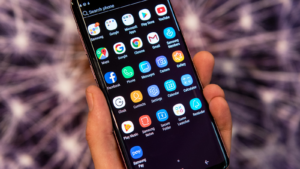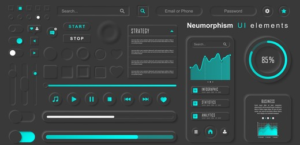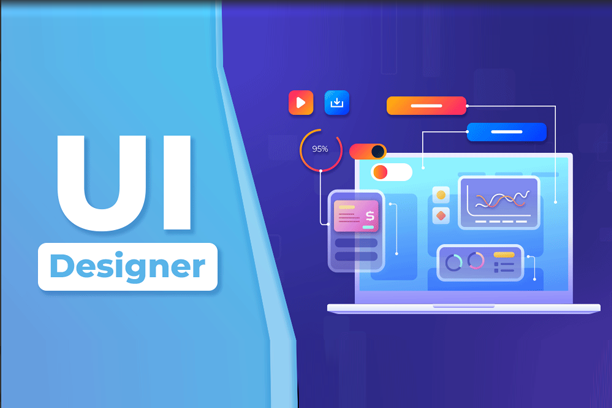Mobile apps are a new way of doing most online activities. An eye-catching and feature-rich mobile app user interface design provides the experience that users want and increases engagement. Therefore, the most important aspect of mobile app development is User Interface design principles.
To make things easier, you can follow these points to design a great UI for your mobile app.
Mobile User Interface Design Principles for 2024:
Content-Centric Approach:
Content is the first element that you need to prioritize to make your app design user-centric. Following this approach emphasizes thinking from the perspective of context, problem, and user. No matter what methodology you use, a content-centric approach will help you create a unified voice.
Tips:
- Use a visual approach to map the entire customer journey, keeping the bigger picture in mind and using a content-centric methodology.
- A lot depends on the methodology used to develop the product. It helps to prioritize which features to release first.
Full-screen size matters:
A few years ago, 16:9 was a popular aspect ratio for mobile screens with physical buttons underneath. However, that trend has changed and modern mobiles use virtual buttons with a 20:9 aspect ratio.
Mobile apps need to adapt to this changing trend and have the flexibility to evolve further with changing trends.
Ideally, your app should make the most of the available screen space.
When designing graphics for full-screen mobile apps, don’t follow the old rule of “one graphic size fits all devices.” It will take less time to develop your app, but it will fail if your users access your app from multiple devices.
Tips:
- Use visual cues and focus on micro-moments to guide users through their journey.
- Understand the importance of accessibility and include dark mode in your mobile app.
Eliminate clutter:
Clarity is a key feature of good mobile app design. A cluttered user interface (UI) never produces good results. Elements like too many buttons or too many images only complicate usability and frustrate customers. Avoid clutter and keep your design subtle to increase visibility.
Tips:
- To improve your User Interface, use a minimalist design approach and focus on only one or two actions at most on a single screen.
- Avoid random content, keep text concise, create titles, and use white space wisely.
Color psychology:
Add professionalism to your app with subtle animations during transitions between screens and pay close attention to your mobile app’s color scheme. Each color tells a different story and evokes specific emotions.
Tips:
- Your mobile app should look like an extension of your website, so choose a color palette that matches your organization’s colors.
- If the button changes color after clicking, it means the user’s action is complete. Don’t forget to include subtle yet effective elements like this in your mobile app’s user interface (UI).
High-Resolution Images:
Modern devices and high-speed internet connections can support high-resolution images. Deliver the perfect user experience on your mobile app with great images and increase engagement levels.
Tips:
- High-resolution images improve your app’s visibility on larger screens.
- We recommend using vector-based images because they are convenient and automatically scale to fit your screen resolution.

Examples of the best mobile app designs:
Starbucks:
This coffee chain is popular for its signature products that linger on the palate. The mobile apps are equally immersive and leave a lasting impression on your senses.
The black, brown, and green colors used in the app are in keeping with the brand’s characteristics and the value proposition it offers (a cup of coffee).
In terms of design strategy, this works well and reminds customers of what the brand offers.
Calm:
The calm images of nature capture the user’s attention and the main screen has few buttons. The color scheme is based on blue, which gives the user a calmer feeling.
Houzz:
Google pioneered the Material Design language in 2014. Since then, it has been widely used in mobile industry apps. Houzz, an app that inspires users with home design and decor ideas, is a prime example of the Material Design theme.
This app won Google Play’s App Design Award. The User Interface of this app allows users to consume more information with minimal effort, providing an example of how you can provide all the information they need in a clear layout.
Text SMS:
Tends to be cluttered, but it’s hard to prioritize and present a clean User Interface to the user. Textra SMS is particularly good at this, offering a clean and uncluttered UI design. Another app based on Google’s Material theme, the app’s design is suitable for both professionals and casual users.
Apple Store:
Proper use of white space in your design gives your mobile app an aura of sophistication and purpose. It clarifies the layout, reduces cognitive load, and emphasizes on-screen elements.
Apple makes smart use of white space in its websites, mobile apps, and other designs.
The Apple Store is one of the best examples of white space most used in mobile apps.
How many platforms do you target?
Some people want to develop mobile apps specifically for a specific platform and don’t mind having a limited reach. For example, some people choose iPhone-only apps to target the wealthy. Native apps are perfect for those users.
If you want to expand your reach, you can choose from multiple native apps developed specifically for each operating system. Hybrid apps allow you to access all platforms through one common app. Hybrid apps have common HTML5 and Javascript code packaged in a native container and are cross-platform compatible.

How complex is the mobile app you want?
The complexity of your mobile app depends on the problem you want it to solve. Some apps are very demanding in terms of functionality, while others are much simpler. Native apps can access hardware like GPS and cameras, manipulate physical keys on the phone, link to online databases, manage large amounts of data on the client side, run offline, and add widgets. You can access them without any problems. All of this is not possible in a web app, but people often realize that it is not possible in a cross-platform app either.
Choose a native app if:
- Apps that require fast response and high performance
- An app that can process large amounts of data on the client side
- Apps that manage system or OS resources
- For video or gaming scenarios
- If you want an app that works in offline mode, web apps are not an option. Hybrid apps can do almost everything a native app can do offline.
What do you expect from a mobile app’s UX?
Some apps (especially online stores and games) require a demanding user experience, while others, like a simple to-do list app, don’t care. If you want a mobile app with an interactive, engaging, and OS-specific user experience, a native app (if designed by a UX expert) is the way to go. However, hybrid apps only provide an average user experience.
There is no such thing as a bad user experience with HTML5 or hybrid apps. What I want to point out here is that it may not be OS-specific. To speed up the development process, they typically rely on a “one size fits all” philosophy, so all phones have a common user interface.
Do you think your app content will pass the approval process?
All restrictions placed on your app’s content, images, and design must pass. Some apps with racist, adult, or inappropriate content are not easily approved.
These apps prefer to stay on the web in the form of HTML5 web apps, where there is no censorship on the content being shared. Some apps, such as Twitter, where users create and share content, now use warning labels before displaying inappropriate content.
What operating systems or platforms are you developing mobile apps for?
If you know which platforms your target audience prefers, you can start with one platform. The main advantage is that while you launch your mobile app for one platform and start measuring key performance indicators (KPIs), you can continue developing your mobile app for the other platform. If you follow this economically optimized method, you will already be making money and partially establishing your presence among your target audience.
What development environments do you support?
Most mobile app development service providers support two development environments: native and cross-platform. The most important determining factors are:
- User experience: There are significant differences in how different platforms, such as Android and iOS, handle human-computer interaction. Native mobile app development allows you to increase value through usability engineering and take full advantage of the features offered by each platform.
- Performance: Native mobile app development provides the best performance because developers interact with features specific to a particular platform. Research from leading institutions shows that performance also influences the level of user satisfaction.
You should also consider your project requirements in advance to determine whether you should proceed with native or hybrid app development. Criteria such as technology, infrastructure, scalability, competition, and changing economic indicators play a key role.
Which mobile app development technologies can I use?
Android and IOS App Development Programming languages allow mobile app developers to write more secure and concise code.
How long does it take to deliver a mobile app?
Let’s create a use case where you need to develop an e-commerce mobile app that uses live user location tracking, push notifications, and voice-based app commands. Now let’s break down the requirements into three-week sprints. The first sprint will deliver a functional mobile app with live user location tracking and push notifications.
Your mobile app is now available to your target audience and can collect feedback. The second sprint will integrate voice-based app command functionality. These are hypothetical time estimates, but you can see how a project can be delivered using agile methods.
So, an agile approach not only allows you to test your mobile app but also implements changes you gather after listening to your audience.

Mobile App User Interface Elements:
Developers and designers focus on elements that can be manipulated to create an intuitive and engaging user interface.
The six user interface elements we will consider are:
- Emphasis:
Emphasis is a design principle used to focus on specific areas within an app. When used correctly, this principle directs the user’s attention to the most important information and features first.
- Balance and Placement:
The principle is to avoid elements looking like they’re about to fall off or drawn haphazardly.
- Contrast:
Contrast is another important design principle. Highlight the differences between elements on the screen. Good contrast highlights different elements and enhances the user experience.
- Proportion:
Large elements stand out more than small ones and therefore draw more attention.
- Motion:
Element shapes, animations, and transitions are important basic utilities for directing the viewer’s gaze on the screen. Motion is the visual path the eye follows within a design.
- White Space:
Finally, white space, also known as negative space, is an important design principle that gives space to other elements on the screen. It helps draw attention to important content and improves readability.
What is A/B testing? How does it work?
Show two versions (A and B) to similar visitors at the same time. This provides empirical data to make better decisions about design elements that directly impact user experience.
This process creates two different versions of your app’s UI. This means the following changes:
- Color scheme
- Button placement
- New feature
- Anything that can impact UX
These versions will be visible to some segments of your user base and the remaining segments will see the current layout. User engagement metrics such as session duration and click-through rate are then compared.
Conclusion:
The design of your mobile app should be a secondary concern and your primary focus should be on creating a structure that makes your app reliable. Also, it’s worth keeping an eye on the future of the mobile app market. The right combination of architecture and design produces a user interface. We highly recommend getting this part right.
